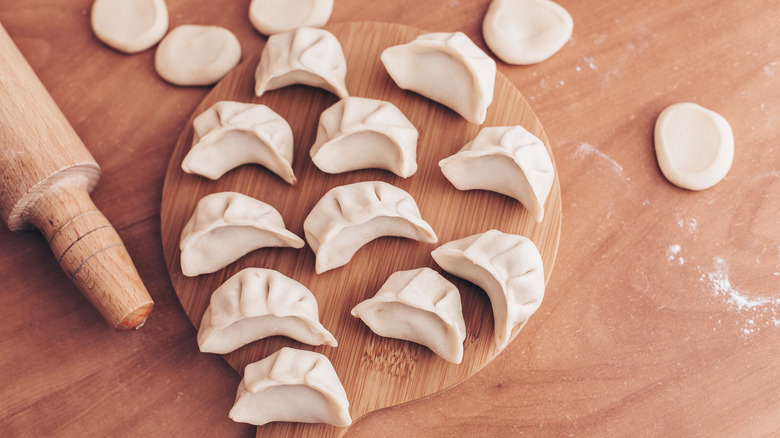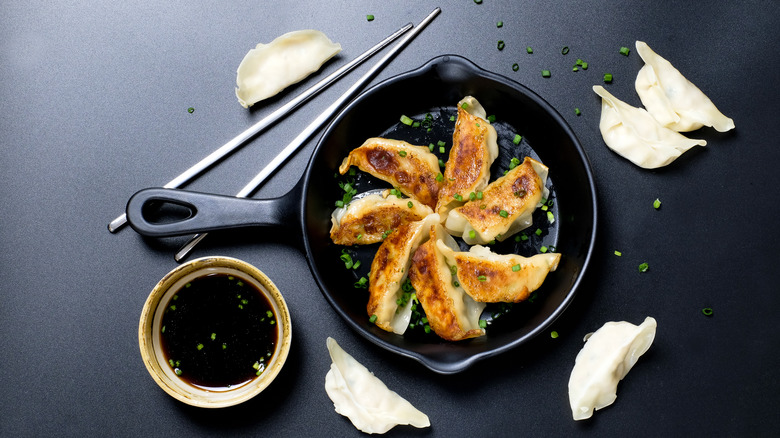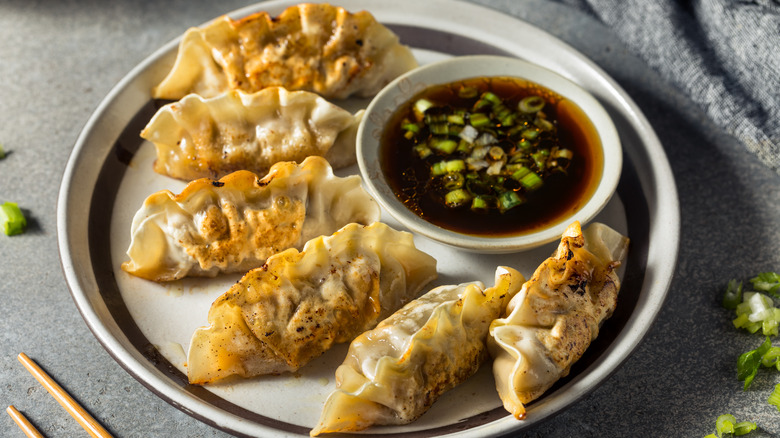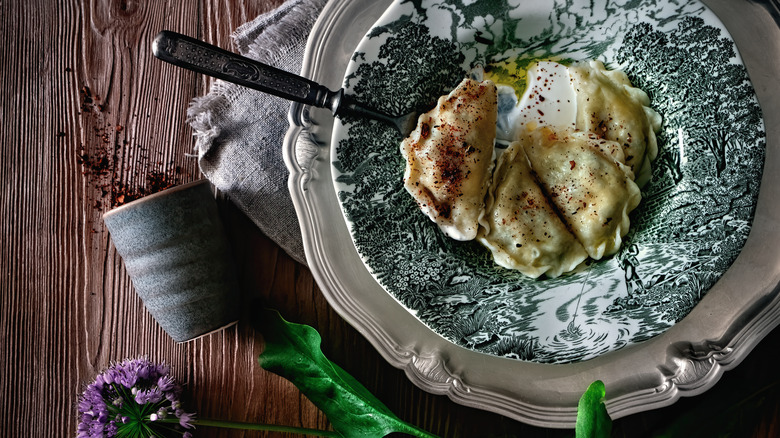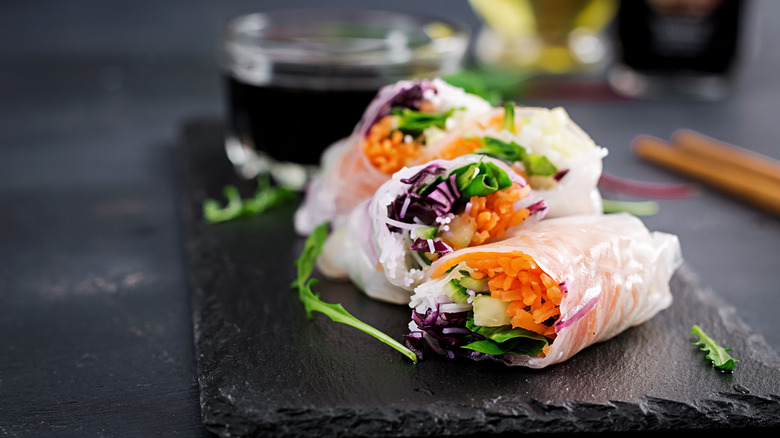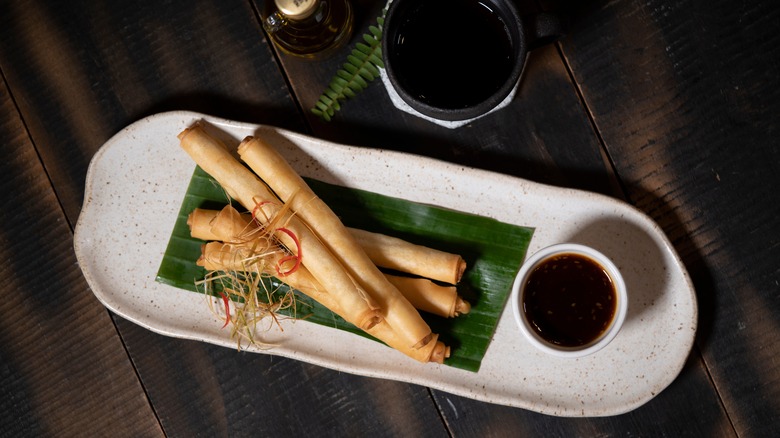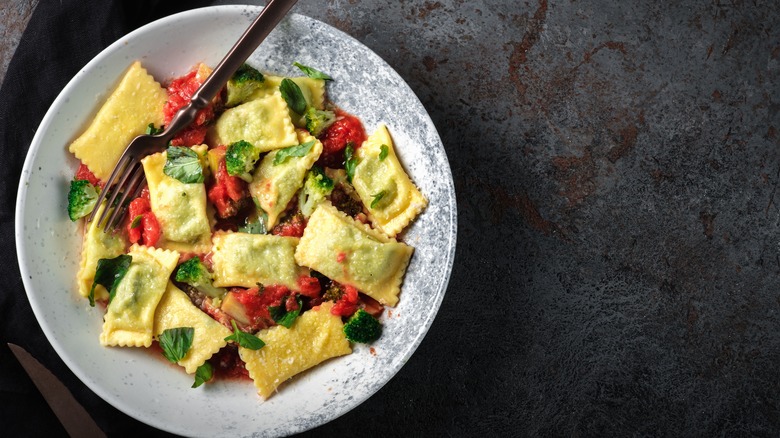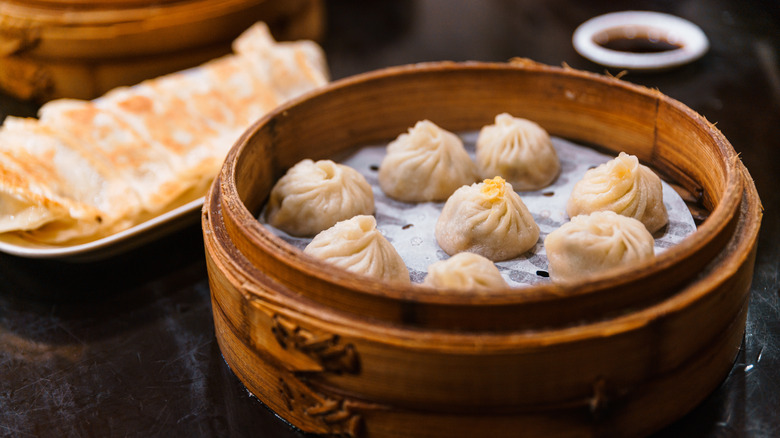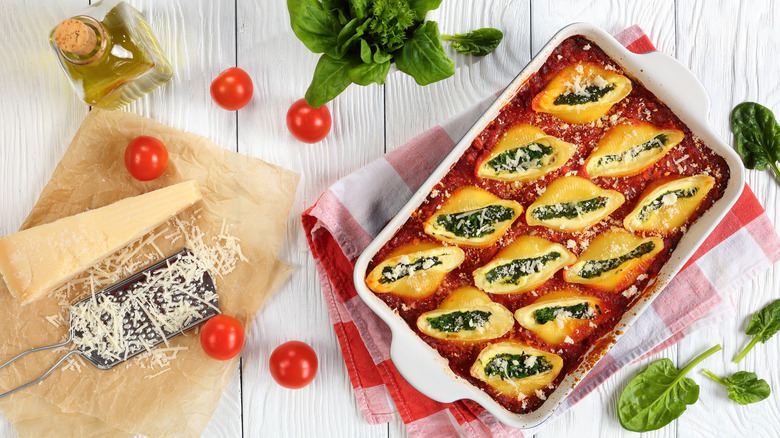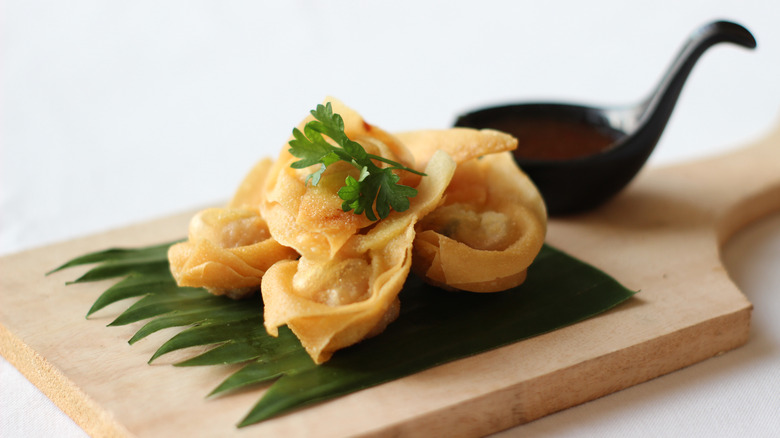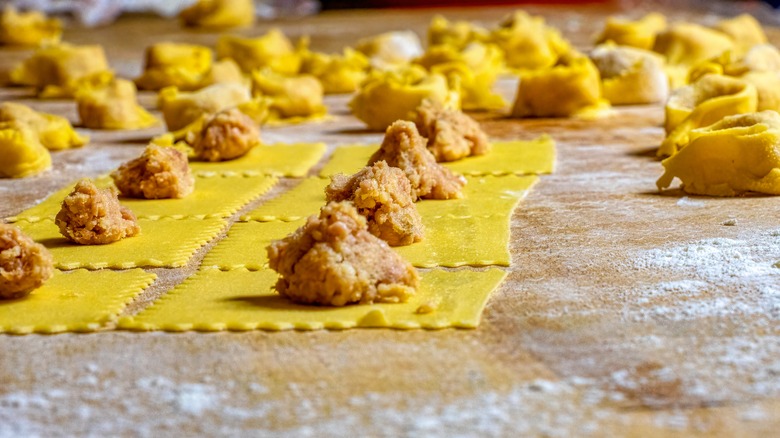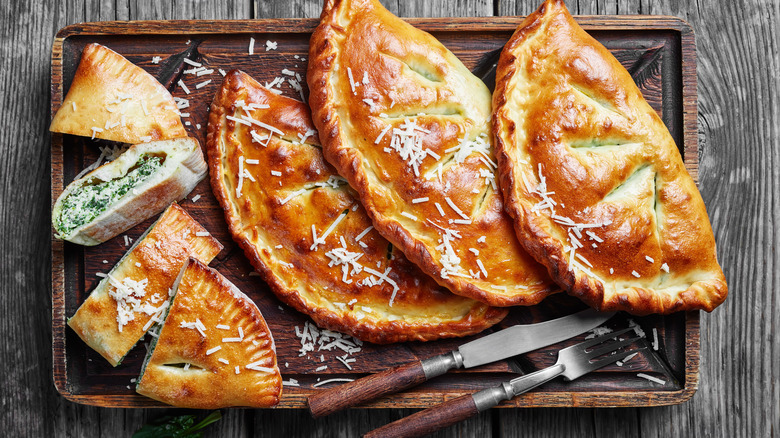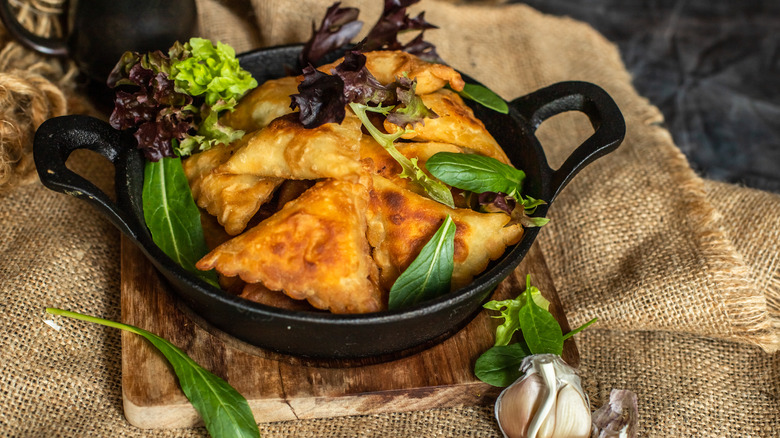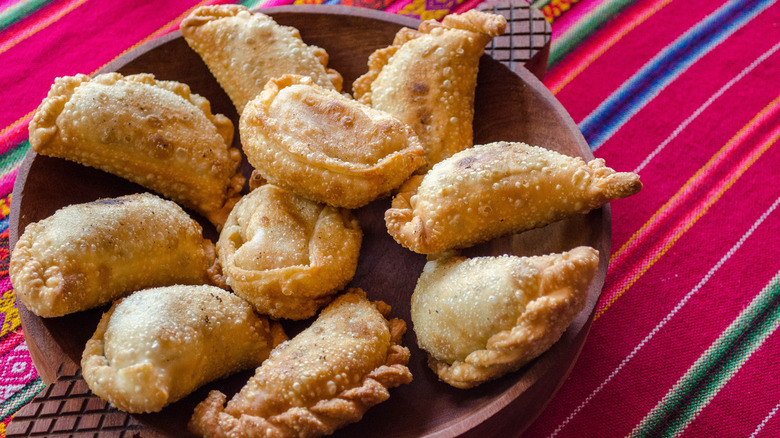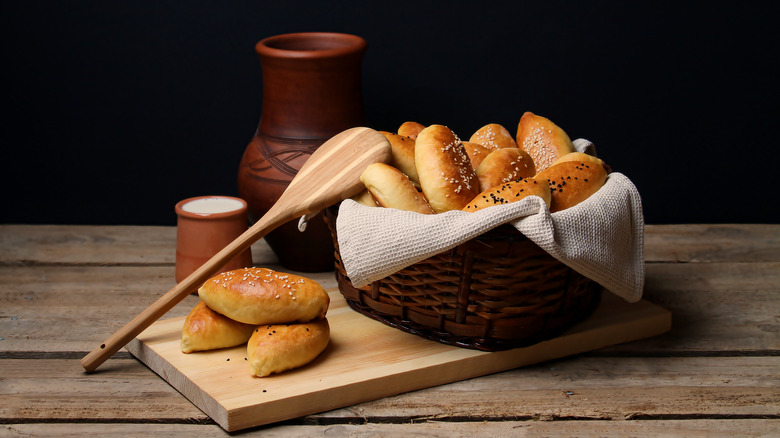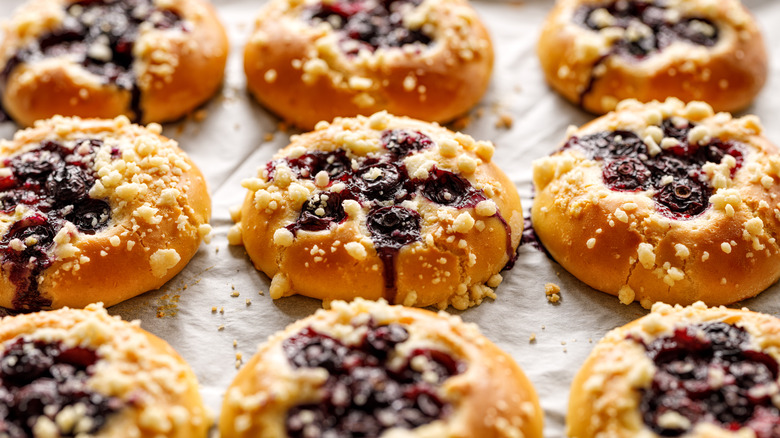Around The World With 15 Stuffed Dough Dishes
We may receive a commission on purchases made from links.
What's better than savory or sweet filling stuffed inside of starchy, carby goodness? This combo is a winner, and the world knows it. You'll find that across many cultures, native ingredients allow for numerous iterations of this ensemble. Fillings run the gamut of potato, meat, veggies, cheese, fruit, and fish. The base these delightful treats live in can be curry, broth, tomato sauce, or anything else you can conjure. But the variety doesn't end there; once cooked, these morsels are served in a multitude of ways. They can be easily purchased and reheated or homemade — you can choose to go the extra mile and make your dough from scratch too.
Wouldn't hosting an "Around the World with Stuffed Dough" party be fun? The best part is that these popular stuffed staples are usually bite-sized and can be served tapas-style, and Amazon just happens to sell toothpick flags of the world for display. So now that we have planned your next party, let's dive into each dish.
Gyoza
Gyozas originated in China but eventually became a popular Japanese dish, per the Japan Culinary Institute. In China, they are known as "jiaozi," but they are referred to as "potstickers" worldwide. Gyozas are dumplings filled with ground meat (usually beef, pork, or chicken) and vegetables wrapped in thin dough. Depending on your preference, you can make them by steaming, frying, or baking. Traditional gyozas will be filled with ground pork, nira chives, green onion, cabbage, ginger, garlic, soy sauce, and sesame oil. However, there are tons of variations on the market and in restaurants.
Gyozas are usually served with a dipping sauce made from a mixture of soy sauce, vinegar, and chili oil (rayu). In Japan, you can find them in ramen shops and izakayas (informal spots for small plates and drinks). They are also on many Chinese-American restaurant menus. You can even get them online; we recommend Umami Cart, which has a Gyoza Sampler with filling options including pork, beef, chicken, and seafood.
Mandu
Mandu is essentially Korea's version of gyoza. It is similar in that it is made with minced meat and vegetables wrapped in a thin piece of dough. Meat fillings typically include shrimp, ground beef, or pork, while popular vegetable fillings include bean sprouts, green onions, or shredded kimchi. Mandu is steamed or fried like gyoza but sometimes simmered in beef stock. It is also usually dipped in a soy sauce and vinegar mixture, with kimchi often served on the side. In Korea, mandu is commonly served as an appetizer at home or picked up from a street vendor. It is also a popular New Year's Day morsel, often added to a soup with a beef stock base.
If you want to try your own mandu, you're in luck; recently, O'Food launched frozen mandu in five styles: kimchi pork, kimchi chicken, kimchi chicken cheese, and — vegetarians rejoice — plant-based gochujang and plant-based Korean barbecue.
Pierogi
While there is much debate about where pierogi originated, they are widely considered a Polish dish. These dumplings are made by filling an unleavened dough with sweet or savory ingredients. They are often dressed with caramelized onions, but you can also top them with bacon bits, sour cream, and numerous other options. They are either boiled and then pan-fried or solely boiled (as a healthier alternative).
Meat pierogi are usually filled with ground and seasoned pork and boiled with lard. Ruskie pierogi (which refers to Rusyns — the people of western Ukraine, eastern Slovakia, and southern Poland), on the other hand, is filled with mashed potatoes, quark (softened cheese), and fried onion. They are also served boiled or fried with caramelized onion on top. Another vegetarian option is pierogi stuffed with chopped sauerkraut and wild mushrooms, also finished with caramelized onion. Sweeter pierogi can be filled with sweet quark and served with sour cream, sugar, and fresh fruit on top — almost like a blintz. Sometimes, the fruit is on the inside of a pierogi — a popular combination is wild blueberries mixed with sour cream.
Cleveland, Chicago, and other U.S. states with a lot of eastern-European influence are very serious about their pierogi. Kasia's is a recommended spot in Chicago if you want to try them in person. Alternatively, you can order pierogi directly from Kasia's website and have them delivered.
Spring rolls
Spring rolls are light and fresh appetizers popular in China and Vietnam. The name "spring roll" comes from its origin; it was served as a dish to usher in the spring season (per Rice Bowl Deluxe). Today, they are typically served at Chinese New Year banquets.
They are made by rolling up a dough wrapper made of rice or flour and filling it with crunchy veggies and herbs like mint, cilantro, and basil. However, beyond traditional vegetables, you may also find these popular appetizers filled with shrimp, slices of pork, and red bean paste. Some spring rolls include glass noodles on the inside as well. They can be fried, steamed, or baked, and are usually served with a hoisin or peanut sauce.
Spring rolls are bright in color because of all the fresh ingredients of many hues. They are perfect for impressing people who eat with their eyes — or to entice children to eat their veggies. If you decide to make your own light and fresh spring rolls, they're super simple to prepare — even for kids.
Lumpia
Although lumpia is a popular dish in Indonesia and the Philippines, it actually derives from Southern Chinese spring rolls. Lumpia is made by filling a thin crepe pastry dough with a mixture of chopped vegetables or meat. The vegetables can range from carrots, cabbages, green beans, bamboo shoots, banana hearts (the purple flower that grows on top of banana clusters), and leeks. If meat is used, it is usually minced and can be chicken, shrimp, pork, or beef. Sweet, dessert-style lumpia is made with bananas and brown sugar.
Lumpia is often served as an appetizer or snack and may be prepared by coating the roll in egg wash and deep frying or baking. A sweet and sour dipping sauce is typically served alongside them, though vegetable lumpia is usually served with a soy sauce called toyo-mansi, or vinegar and chili peppers.
Frozen, pre-made lumpia is not easy to find, but with online specialty stores like Fil Am Store, you can have some shipped to your home.
Ravioli
Plump pillows full of rich ingredients, ravioli is always a great comfort dish. The word "ravioli" means "little turnips" in Italian. The dough is usually an egg pasta, shaped into rectangles or circles with crimped edges to keep the filling inside. Across Italy, ravioli is made with different fillings — in Rome and Latium, they are made with ricotta cheese, spinach, nutmeg, and black pepper. In Sardinia, ravioli is filled with ricotta and grated lemon rind. You can also find them stuffed with meat, vegetables, cheese, or fish these days. Ravioli is served in various sauces, depending on the filling: examples include tomato sauce, cream sauce, butter and sage, or bolognese. They can be boiled like pasta, or fried so they are nice and crispy.
There are a number of ravioli recipes you can try at home, with fillings ranging from egg yolk and ricotta to butternut squash and crab mixes. You can also purchase a ravioli kit from Global Grub, or pick up a pack at the grocery store. For a gluten-free option, Cappello's makes grain-free ravioli using almond flour — their spinach and cheese ravioli is fantastic. The Cappello's brand can be found in many grocery stores, but ordering from their website is another, convenient option.
Soup dumplings
Soup dumplings are kind of meta. Upon hearing the name, you may think that it implies "dumplings in soup," but these dumplings actually burst with soup when you bite into them. "Dim sum darlings," "xiao long bao," or "soup dumplings," translate to "small basket buns."
Incredibly, soup and an aromatic pork meatball are precariously enclosed in these doughy wrappers without spillage. The addition of aspic to the collagen stock filling causes the soup component to gel when steamed, making it easier to keep contained. It is truly an art to make these — they require exactly 18 pleats on the top of the dumpling to be considered perfect.
With that said, these are kind of intense to make yourself, so if you are not up for the challenge, order some from Fly by Jing's online store. Developed by Chinese chef Jing Gao, these soup dumplings are authentic and delicious.
Stuffed shells
Picture it: Sicily. It's a Sunday afternoon, and friends and family are coming over for lunch. The spread is ready with stuffed shells presented prominently on the table.
Stuffed shells are a classic Italian recipe hailing from Sicily that is slightly similar to Manicotti or Cannelloni. These traditional Sunday lunch favorites are jumbo pasta shells (called "conchiglioni ripieni al forno" in Italy) stuffed with ricotta, mozzarella, and parmesan cheese filling. From there, they are covered in a red or white sauce and baked until everything is gooey inside and bubbling on top.
They are a great vegetarian option, but they can be prepared in numerous other creative ways, such as adding meat and veggies, or breading and frying your pasta shells. We have a few stuffed shell recipes worth checking out: Try your hand at a sausage and spinach filling, which is topped off with three different Italian cheeses and a decadent garlic cream sauce. Or, cook up a vegetarian option using butternut squash and burrata. If you're feeling extra cheesy, this five-cheese stuffed shell recipe really hits the spot. È delizioso!
Wontons
Wonton soup is a well-known Chinese-American dish; however, traditionally, wontons are served in various other styles across China. A wonton is a Chinese dumpling usually filled with a ball of ground pork and shrimp and a small amount of flour, added as a binder. The mixture is seasoned with salt, spices, and garlic or finely chopped green onion. Once the filling is added, one of several folding methods is used to close the wonton.
In Cantonese, "wonton" roughly translates to "swallowing a cloud," and we can see why — the fluffy dough enveloping soft fillings evokes a light and airy feeling. These can be steamed, deep fried, or added to a broth for a wonton soup recipe. In Sichuan, wontons are served in a chili oil sauce and white sesame paste. Other regions serve wontons in a broth topped with a seaweed called zicai, fried egg, and green vegetables. If you're looking for premade, frozen wontons, Wonton King is a highly recommended brand that can ship its products directly to you.
Tortellini
Tortellini is a super versatile type of stuffed dough hailing from the northern region of Emilia-Romagna. This shell-like shaped pasta is typically loaded with a mix of meat (chicken, pork loin, raw prosciutto, or mortadella), Parmigiano Reggiano cheese, egg, and nutmeg. They can be served in various sauces as a pasta dish or in broth for soup.
In Italy, it is traditional to serve tortellini in broth on Christmas Eve, but they can be deep fried and served as finger foods with a marinara dipping sauce. They are a perfect side to bring to a BBQ when served cold, mixed with veggies and some pesto. You can get as creative as you want when making your own, and it is easy to find a variety of tortellini pre-made at the grocery store. If you're going to cook some up yourself, consider making tortellini soup. Or, try a vegetarian-friendly tortellini stuffed with spinach, ricotta, and mascarpone.
Calzones
Think pizza in a pie crust — we're drooling. Calzones hail from Naples, Italy, but have made their way into American culture and onto the menus of most pizza shops. It is a circular piece of pizza dough stuffed with ricotta and sometimes mozzarella and parmesan. You can also add cured meats and veggies. After the dough is filled, it's folded over and sealed using a crimping technique, brushed with egg wash, and baked. On the other hand, mini calzones, called "panzerotti," are sometimes fried. Tomato sauce is often served on the side with calzones rather than be a part of the filling to keep it crispy.
One calzone is usually enough to serve two people, but personal calzones are also an option. Sure, you can pick these up at your local pizza place, but they can be simple and fun to make at home. Or, you can have CG Pizza come and cook them at your house in their mobile pizzeria with a wood fire oven trailer (if you live in New York or New Jersey). Their high-hydration (any New Yorker of New Jersian will tell you — it's all about the water), 24-hour fermented dough, simple sauce made from sumptuous tomatoes, extra virgin olive oil, and fresh basil make for a party favorite. If you don't live in the land of perfect pizza water, Harry & David has some delicious calzones available for online purchase.
Samosas
Crunchy, spicy, and savory, samosas are a popular Indian treat. Sometimes called "singara," these are filled with diced potato, onions, green peas, lentils, ginger, spices, and green chili. The dough is a white flour called "maida" that can be fried or baked. Once sealed, they are brushed with ghee and deep-fried until golden. They are served with fresh green chutney, which can feature mint, coriander, or tamarind. Another way to serve samosas is with yogurt, chutney, chopped onions, coriander, and chaat masala. Different regions make their samosa in various shapes, ranging from triangles and cones to half-moons.
Samosas are usually enjoyed as an appetizer or alongside afternoon tea. They are also a favored street food in India. As we are not fortunate enough to have carts of delicious and aromatic samosas at our disposal in the U.S., you will have to purchase these from your local Indian restaurant, frozen at the grocery store, or make your own. Our samosa recipe is a lighter version, using an air fryer instead of deep frying, and opting for phyllo dough (Athens is a great dough brand for this) in place of flour.
Empanadas
Although they are most popular in Argentina, empanadas are made in many countries, including Venezuela, the Philippines, and Mexico. They are prepared differently depending on which region of the world you're in, but they are all made with dough folded over ground meat, a couple of vegetables, and lots of spices. They are then either baked or fried. In shape, they are hand-held turnovers that are easy to eat on the go or while mingling at a party.
The most well-known empanada styles will feature a flaky crust enveloping seasoned ground beef or chicken and vegetables. The spices used can include cumin, cinnamon, and chili peppers. In many areas, fish empanadas are the norm — featuring tuna, codfish, or sardines. These variants are prevalent during Lent and Easter in Spain. In Argentina, you might see goat, raisins, and olives in your empanada, while in Chile, empanadas will be filled with onions, ground beef, olives, raisins, and hard-boiled eggs. You can try out your own variety of sweet or savory empanadas from Nuchas if you order them through Gold Belly.
Pirozhki
Pirozhki is a traditional Russian and Ukrainian hand pie. Pirozhki consists of a sweet or a savory filling encased in a soft and fluffy dough. Common savory fillings include ground meat, mashed potato, mushrooms, boiled egg with scallions, or cabbage. Typical sweet fillings are fruit (apple, cherry, apricot, lemon), jam, or quark. The dough, like the fillings, can vary: Puff pastry and buttery bread types are usually used. After the pirozhki is assembled, it is glazed in an egg wash before baking or frying.
These are common street foods in Eastern Europe and should be small enough to hold in one hand and eat in two or three bites. To eat them as a proper meal, dip them in some soup. If you want to try to recreate these Eastern European faves, try this Pirozhki recipe by Anya von Bremzen, author of "Mastering the Art of Soviet Cooking." Or head to Gold Belly and order some pre-made.
Kolach
Kolach first became popular in Texas among Czechs who settled there (per NPR). Today, you'll find that Czech-American kolaches are a common delicacy, made with flaky and puffy dough (usually puff pastry) filled with quark, tvaroh (farmer's cheese), fruit jam, and poppy seeds mixed with powidl (a prune plum paste). Some have a touch of spice due to adding mace or nutmeg. They are not cloyingly sweet, but they do have a fruity lift that's tempered by the richness of the buttery pastry and cheese. If you are looking for a touch more sweetness, make or buy yours with a sprinkling of streusel on top.
Often served as breakfast, their grab-and-go quality is an excellent accompaniment to your morning coffee. If you want to get your hands on this Texas favorite, Czech Stop Little Czech Bakery offers sweet and savory kolaches that can be shipped all across the country.
